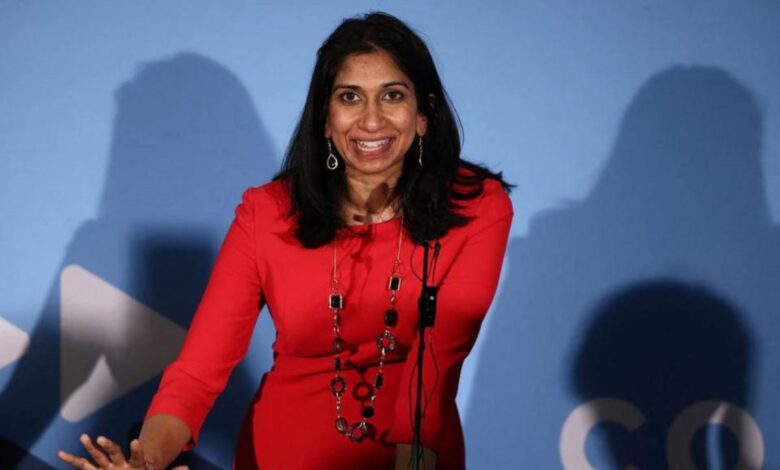Indian-Origin Suella Braverman Elected As UK’s New Home Secretary: Know All About Her!

Indian-Origin Suella Braverman Elected As UK’s New Home Secretary: Know All About Her!
Suella Braverman, an Indian-origin barrister, has been chosen by Prime Minister Liz Truss to be the new home secretary of the United Kingdom even though Rishi Sunak has not taken up any positions in Liz Truss’ cabinet.
Priti Patel, a fellow employee who held the position in Boris Johnson‘s administration, has been replaced by Braverman. The government’s intention to transfer asylum seekers to Rwanda and the implementation of tax cuts are two of her main concerns in her role as Home Secretary.
One of the most diverse Cabinets in the UK has been presented by Prime Minister Liz Truss, with important front-line positions going to members of Parliament from ethnic minorities, including Suella Braverman, an Indian-origin Home Secretary.
On Wednesday, when Truss answers her first Prime Minister’s Questions (PMQs) in the House of Commons, the process of choosing the Cabinet will continue.
Suella Braverman, a barrister of Indian heritage, was appointed as the UK’s new Home Secretary on Tuesday, succeeding fellow Indian-born colleague Priti Patel.
One of the first candidates to enter the race to succeed Boris Johnson as Tory leader and the prime minister was the 42-year-old Fareham Conservative Party member of Parliament, who previously served as the Attorney General in the government led by Johnson.
Prime Minister Liz Truss, who was just appointed, chose Braverman as her home secretary.

The daughter of Goan-origin father Christie Fernandes and Hindu Tamil mother Uma is the mother of two children. In the 1960s, her mother moved to the UK from Mauritius and her father left Kenya.
According to the BBC, Braverman will be in charge of initiatives like the government’s controversial plan to transfer some asylum seekers to Rwanda.
Braverman, a key member of the pro-Brexit branch of the Conservatives who wants a decisive split from Europe, including taking the UK out of the European Court of Human Rights, stated, “I want to embrace the opportunities of Brexit and tidy up the unresolved difficulties… and slash taxes” (ECHR).
“They cherished Britain. It encouraged them. It offered them safety. This nation gave them a chance. My political stance, in my opinion, is greatly influenced by my background “Braverman talked about her parents in the July campaign film for her leadership position.
Key Conservative pro-Brexit figure Braverman said, “I want to embrace the potential of Brexit and tidy up the unresolved challenges… and lower taxes.” Braverman seeks a definitive break from Europe and wants to remove the UK from the European Court of Human Rights (ECHR).
“Liz is now ready to serve as PM. Her on-the-job training won’t be necessary. Furthermore, the work must be done correctly and is difficult. After six challenging years for the party, stability is desperately required “Regarding her potential boss at Downing Street, Braverman stated.
The 2018 bride, a Cambridge University law graduate, wed Rael Braverman. Last year, her maternity leave, which allowed her to continue serving as a Cabinet minister while travelling to give birth to their second child, famously led to a long-overdue legal amendment.
Buddhist Braverman took her oath of office in Parliament based on the ‘Dhammapada’ text of Lord Buddha’s sayings. She routinely attends the London Buddhist Center.
Suella Braverman’s wealth

Suella Braverman, who has been appointed the new Home Secretary of the United Kingdom, has a net worth of between $4 million and $6 million.
On Tuesday, Britain’s new Prime Minister Liz Truss made some of the most important Cabinet appointments, including Suella Braverman, an individual of Indian descent, as her Home Secretary. What you need to know about Braverman is as follows:
- Sue-Ellen Cassiana Fernandes, Suella Braverman’s birth name, was Sue-Ellen Braverman.
- Indian-born parents gave birth to Braverman in the UK. She has Goan and Tamil origin. Her mother, Uma, was born into a Hindu Tamil Mauritian household, whilst her father, Christie Fernandes, is from Goa. In the 1960s, her parents both immigrated to the UK.
- After receiving his education at Heathfield School in London, Braverman moved to Queens’ College in Cambridge to study law. At Pantheon-Sorbonne University, she also earned a master’s degree in European and French law.
- She began her political career in 2005 by running in the Leicester East district for the general election, where she came in second.
- In May 2015, Braverman was chosen to represent Fareham as a Conservative. Since then, she has served in the legislature after being re-elected in 2017 and 2019.
- Conservative Party of the UK member Suella Braverman previously held the position of Attorney General from February 2020 until September 2022. From January to November 2018, she also served as the Department for Exiting the European Union’s Parliamentary Under Secretary of State.
- The 42-year-old belongs to the Buddhist Triratna Community. She accepted the “Dhammapada” as her oath of office in front of Parliament.
- She was named the UK’s Secretary of State for the Home Department on September 6, with responsibility for overseeing immigration and policing; this position is regarded as one of the government’s most difficult and will put her legal knowledge to the test.
- She was one of the 28 so-called “Spartan” Tory MPs who voted against Theresa May’s Brexit plan on all of the 3 instances it was presented to a vote in parliament.
- Braverman’s reputation as an ardent Brexit supporter and she is well-liked by Conservative Party members due to her right-wing cultural warrior views.




